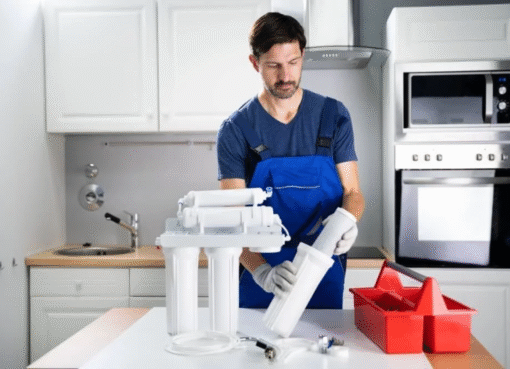Cleaner, Softer, Smarter: A Fresh Look at Home Water Solutions

Let’s be honest—most of us don’t think too hard about the water that flows from our taps. We drink it, cook with it, shower in it, and trust that it’s “fine.” But “fine” is doing a lot of heavy lifting in that sentence, isn’t it?
Maybe you’ve noticed your skin feels dry after a shower. Or your dishwasher’s leaving streaks. Maybe your coffee doesn’t taste quite right, no matter how fancy the beans are. These little annoyances? Often, they trace back to your water quality.
That’s where modern water softeners, water filtration systems, reverse osmosis systems come into play—not as one-size-fits-all solutions, but as a trio of tools that work together (or separately) to improve your water and, honestly, your everyday life.
Let’s dive into how each one works, why you might need them, and what real-life benefits you can expect—no buzzwords, no gimmicks, just cleaner, better water.
The Case for Caring About Your Water
We’re not just talking taste (though that’s a big part of it). The water in your home touches every part of your routine: your clothes, your dishes, your morning routine, even your plumbing and appliances. And depending on where you live, that water might contain all sorts of unwanted extras—minerals, chlorine, sediment, even trace chemicals or bacteria.
This isn’t fearmongering—it’s just reality. Municipal water is treated to be safe, not necessarily ideal. And if you’re on a private well, there’s even more uncertainty. That’s why more homeowners are investing in water solutions that go beyond the basics.
First Up: Water Softeners (Say Goodbye to Hard Water)
Hard water is loaded with minerals like calcium and magnesium. Not dangerous, but annoying. Over time, these minerals build up in pipes, leave residue on dishes, fade clothing, and make soap and shampoo harder to rinse. You’re left using more products, more elbow grease, and more time.
Water softeners work by replacing those minerals with sodium or potassium ions using a process called ion exchange. The result? “Soft” water that’s easier on everything it touches.
Signs you might need one:
- You see white, chalky buildup on faucets
- Your clothes come out stiff or dingy
- Your skin and hair feel dry no matter what you use
- Your water heater is losing efficiency (scale buildup is often the culprit)
Soft water can extend the life of your appliances, reduce cleaning time, and even save on detergent and soap. It’s one of those upgrades you don’t think you need… until you get it.
Next Up: Water Filtration Systems (Because “Clean” Can Always Be Cleaner)
While softeners remove hardness minerals, they don’t do much about other contaminants like chlorine, pesticides, heavy metals, or funky smells. That’s where water filtration systems come in.
These systems use various types of media—activated carbon, sediment filters, UV lights, etc.—to target and remove specific contaminants. Some are whole-house systems that treat every drop coming into your home. Others are point-of-use filters, like the kind you install under the kitchen sink.
Why consider one?
- Your water smells like bleach (chlorine overload)
- You’re concerned about lead, VOCs, or other harmful contaminants
- You just want water that tastes and smells better—period
Filtration is especially valuable for families with kids, homes with aging pipes, or anyone looking to reduce their reliance on bottled water. And honestly? Once you taste filtered water, it’s hard to go back.
The Gold Standard: Reverse Osmosis Systems
If softeners and filters are the workhorses, reverse osmosis (RO) systems are the overachievers. RO uses a semi-permeable membrane to remove up to 99% of total dissolved solids, including things many other systems miss—like fluoride, nitrates, arsenic, and certain bacteria.
An RO system is typically installed under the kitchen sink and provides a separate faucet for ultra-clean drinking and cooking water. Some systems also include a remineralization stage to add back healthy minerals for improved taste.
RO might be right for you if:
- You drink a lot of tap water and want the cleanest version possible
- You’re on a well with variable water quality
- You want to eliminate fluoride or other trace contaminants
- You’re tired of hauling bottled water home every week
It’s a small system with a big payoff—pure, safe water on demand.
Do You Need All Three?
Not necessarily. Some homes benefit most from a single solution, others might need a combination. A common setup? A water softener to protect pipes and appliances, a whole-house filter to improve taste and smell, and an RO system for drinking and cooking water.
The right solution depends on your local water quality, household size, usage habits, and personal preferences. That’s why water testing is a smart first step—it helps you understand what’s in your water, so you’re not just guessing.
Real Benefits, Real Life
Here’s what people usually say after making the switch:
- “My skin feels so much better.”
- “The dishes actually sparkle now.”
- “The coffee tastes cleaner.”
- “I didn’t realize how gross my water was until I changed it.”
Cleaner water makes everyday things just… easier. You use fewer products. You spend less time scrubbing. You feel better drinking what comes out of your faucet. And honestly, that peace of mind? Kind of priceless.
Final Thoughts: Make Water Work for You
You don’t have to settle for “meh” water. You don’t have to keep living with soap scum, weird smells, or suspicious tap taste. Whether you’re looking to soften, filter, or purify, there’s a system that fits your home and your needs.
And remember—water softeners, water filtration systems, reverse osmosis systems aren’t about being fancy. They’re about feeling confident in what’s flowing through your pipes and into your glass.
Because water should work for you. Not the other way around.
Leave a Reply
You must be logged in to post a comment.




Leave a Comment